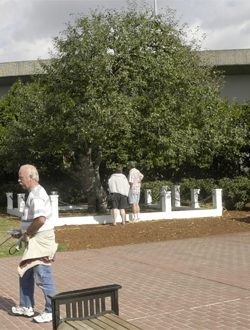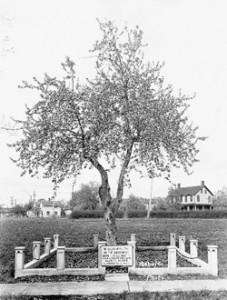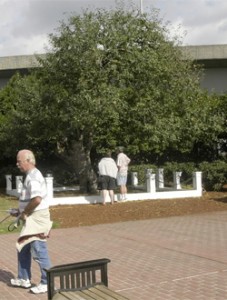Some say that it is the “oldest apple tree” in the Northwest. Some even say it may be the oldest on the west coast.
That may still be in dispute. Whatever the story, all the tales about Vancouver’s apple tree are interesting and share a lot of facts.
It all started at a party in London…A lady at a farewell dinner party for Lieut. Emilius Simpson, the cousin of Hudson’s Bay governor Sir George Simpson, playfully put the seeds of her desert apple into his waistcoat pocket. She asked him to plant them when he arrived at his destination on the other side of the world.
Emilius Simpson arrived in Vancouver in November of 1826 and was soon invited to dine with Dr. McLoughlin in the stockade on the present Deaf School site. During the evening he absentmindedly stuck a finger into his waistcoat and discovered the seeds.
Dr. McLoughlin, Simpson and Pierre C. Pambrun planted the apple seeds in small boxes which were put under glass. Dr. McLoughlin kept the boxes in the store where they could not be touched.
The apple tree was planted outside the fort when he felt it could survive. Around 1830, Washington’s first apple harvest occurred. It was here in Vancouver, and produced one apple. The apple tree has produced a crop every year, although most trees of its kind only live 50-70 years. The “old apple tree” is now about 170 years old.
It has survived many trials, the city’s flood of 1894, the emergence of the railroad, the choppers block in 1910, losing a limb in the winter of 1950, the Columbus Day storm in 1962, and freeway construction in more recent years.
There is an apple tree festival each year which takes place in the historical apple tree park.
Life Along The Riverfront Bore Fruit
By The Old Apple Tree – as told to BRIAN J. CANTWELL, Columbian staff writer
08/16/1987
I have seen a lot on this riverfront. There are probably as many stories as drops of water in the Columbia.
And that’s a river that pumps more water in one day than the amount of soda pop Americans guzzle in 17 years. The river drains an area larger than France.
As it passes, I sip a little myself, from the water table that feeds the spongelike earth below my roots. I’m the Old Apple Tree. I’ve seen a lot of the history of Vancouver and the river. Floods, ice jams, storms. Bad times, good times, even visits by Russians.
Which goes to show this isn’t just a story of flowing water. It’s a story of people, all sorts. Of nearly naked red men and women of the Chinook tribe, gobbling salmon and summer berries on the river bank as Gorge-funneled breezes cooled them.
Of sweating Hawaiians, far from their plumeria-perfumed islands, herding pigs and hauling wood for Fort Vancouver fur traders.
Of homesick Texans and other transplants, taking a break from welding World War II aircraft carriers to dangle their feet from shipyard ways and ponder Mount Hood as they wolfed sandwiches from metal pails.
A lot of water has flowed beneath the Interstate 5 bridge since it was built 70 years ago. But I was around long before the bridge.
OK, I wasn’t here when Lewis and Clark paddled by. But those two didn’t actually land right here, although some people today want to erect a statue of them climbing Vancouver’s riverbank; actually, so I’ve heard, the explorers stopped at Frenchman’s Bar, about six miles downriver, and Government Island, about five miles upriver, on their round-trip to the Pacific. Close enough?
I’ve heard historians talk about it. I’ve been growing here since about 1826, planted from seeds brought from England by a captain at the fort, people say. So I’m about the oldest living thing in the neighborhood. Maybe the oldest apple tree in the Northwest.
Even if Lewis and Clark didn’t stop right here in 1805, Meriwether Lewis had some nice things to write about this spot on the river: “This valley is indeed the only desirable situation for a settlement which I have seen on the west side of the Rocky Mountains.”
He must have craned his neck as he passed.
This old tree put up with a lot those early days. Immediately to my north was the center of Kanaka Village, a roughly hewn collection of buildings housing rough-talking French Canadian trappers, Englishmen, Scots, Hawaiians and various Native Americans who worked around the Hudson’s Bay Co. fort. They were the types that picked a sapling’s first apples when the fruit was barely big enough to eat. The village was named for the Hawaiians, called Kanakas in the slang of the day.
This Kanaka Village, the first collection of homes outside the fort’s walls, was the historic nucleus of the city of Vancouver, says Jim Thomson, the superintendent of today’s Fort Vancouver National Historic Site. Today, much of the village site is almost buried under ribbons of concrete linking Interstate 5 and state Highway 14.
Before all that, however, there was a glorious, unobstructed view of the Columbia River and the ships moored at the fort’s dock. A pond once reached inland just east of where Who Song & Larry’s restaurant stands today. When you sit out on Who Song’s deck and sip a beer, imagine yourself on the dock where the West coast’s first steamship, the Beaver, once took on furs for shipment to capitals of the world. Next to the dock was a salmon house where Hudson’s Bay Co. workers processed and smoked salmon for shipment to the Orient.
After 1849, when the American military moved in and established Vancouver Barracks, this dock eventually became the government dock, where supplies where unloaded for what was once the largest military post in the Pacific Northwest.
That was the center of action on this strip of waterfront for many years. Meanwhile, to the east where steel bridge girders are forged and all sorts of materials recycled today at Columbian Industrial Park, the land was farmed, first for the fort and barracks, later by private owners such as Lowell M. Hidden.
Hidden arrived from New England about 1864. In 1865, he bought 200 acres, stretching from the riverbank (now part of the industrial park) up the hill to what is now Mill Plain Boulevard. His grandson, Robert Hidden, a brickyard owner and guardian of local heritage, describes the land as “2 feet of topsoil over 90 feet of gravel.” The farm grew corn, potatoes, carrots and hay.
I watched the town develop around me all this time. A lot of apples grew and fell. When Lowell Hidden first came here, he might have stayed at Alta House, a hotel and boarding house that stood on a high foundation amid mud at the river’s edge. It was near where the Interstate 5 bridge crosses today. Alta House was a well-known hostelry where men in top hats and women in corsets and bustles came to see touring troupes of entertainers.
In this waterfront history, perhaps the most significant event – it definitely affected the waterfront’s long-range future – was construction in 1908 of the Spokane, Portland & Seattle Railway. Its tracks paralleled the river and ran east up the Gorge. The railroad had the dual effect of improving access to the waterfront for industry while decreasing access to the waterfront by the general public. The tracks, built on a high dike safe from floods, created a barrier, diminishing Vancouver’s easy access to the river and blocking the beautiful view.
For the first time, I felt landlocked. The Vancouver waterfront’s future as a place for apple trees didn’t look promising. To make matters worse, a railroad spur was built just north of me where coal was dumped in untidy heaps to supply the barracks.
My view of the river was lost, so who am I to continue this tale? I’m a survivor, a living thing of bark and sap that has lived through all that Vancouver has lived through, as I’ve sat at what has become the hub of transportation in Southwest Washington. So let me tell you more.
The next big change was the Interstate Bridge, constructed in 1917. It meant an end to ferry runs that had docked near the same spot. About the same time, modern life established its presence, as the first electrical substation was built to serve Clark County. The building still stands, at the east side of the bridge’s north end.
With 1917 came World War I, and a flock of new troops to Vancouver barracks. The barracks become headquarters for a military sawmill operation, cutting Northwest spruce, light and strong, that was then shipped from the government dock for the manufacture of biplanes and other fighting planes that looped and buzzed over the skies of Europe. Lucky they didn’t want apple wood.
About three miles east, boat building had come to my stretch of waterfront about 1900 at a lovely cove along a grassy shore immediately west of what is now Wintler Park. The site today is home to Tidewater Barge Lines. Work there has included repair and maintenance of boats and barges, and construction of small boats and tugboats.
World War I brought more boat works. G.M. Standifer Construction Co. built a yard with six ways in 1917 to build wooden ships for the war effort. The yard was immediately west of the Interstate Bridge, where the Inn at the Quay stands today. Standifer built ships with odd names, such as the Moosabee and the Benzonia. Standifer built another yard, to construct steel ships, just downstream from the railroad bridge, about a mile to the west. Standifer closed the shipyards in 1921.
Once someone whispered the words “boat building” here, it was as if that pursuit were somehow stamped genetically into the soil of this shoreline. I’m surprised I haven’t grown apples with a bow and a stern. It took only two more words to alter this town’s future forever: Pearl Harbor.
The Hiddens still farmed their riverfront, along with neighbors, the Boss family, next door to the east, when Henry Kaiser came to see them in 1942. The government had tapped Kaiser, whose credentials as a miracle builder were established at Bonneville and Grand Coulee dams and elsewhere, to build ships, lots of them, to fight a war America intended to win.
Kaiser chose Vancouver as the site for one of his shipyards. He bought about 100 acres from the Boss family. He leased about 100 acres from the Hiddens for $300 a month, about the same income earned by the farm.
The Kaiser shipyards changed the face of the waterfront. A dozen ship ways were built, where Liberty ships, the slow but sturdy merchant ships that carried troops and arms, small aircraft carriers (called “baby flattops”) and other warships were launched with unprecedented speed. Plans for the shipyards were announced in January 1942, and the first ship was launched that July. You can still see the ship ways from the river, or if you stand out on the dock at Marine Park. Some of the big, old buildings at Columbia Industrial Park were the original shipyard structures.
The shipyards also brought newcomers by the thousands to town. Vancouver, my quiet hometown of 18,000 people in 1941, swelled with migrations of job-hungry people from every corner of the nation. The population tripled within two years. By January 1944, the population of “the Vancouver metropolitan area” was 95,000, according to a Vancouver Housing Authority history. At the peak of employment, 38,000 people worked at the shipyards. When a trainload of new workers arrived from Brooklyn and the Bronx, The Columbian took it upon itself to remind longtime residents that these too were Americans, even if they did say “dese” and “dose” and wore their hats while they ate.
New houses and apartments rose like weeds after a spring rain, across the city and near the riverfront. Hudson House, a collection of seven dormitories with 5,018 beds, stood where Portco Corp. and the Marine Park picnic area exist today.
At the height of production, work never stopped on the ships. Early in the morning or late at night, you could hear the roar of construction. It was enough to shake my apples, like the continuous roar from race cars at Portland International Raceway. They were exciting times, though. I saw a lot of important people drive by, such as Eleanor Roosevelt, the first lady, here in April 1943 to christen the Alazon Bay, the yard’s first aircraft carrier. About 75,000 people came to watch.
By the time shipbuilding ceased at the yards in 1946, the production record stood at 10 Liberty ships, 30 tank-landing ships, 50 escort aircraft carriers, 31 attack transports, 12 C-4 troop ships, eight C-4 cargo vessels and two 14,000-ton dry-docks. That’s 141 military ships in less than 44 months.
The shipyards left a legacy of industrial use on a big stretch of the riverfront. A hydrogen peroxide plant rose in 1951 on the site of a shipyards parking lot west of today’s industrial park. FMC Corp. operated the plant until it closed in 1983.
Down my way, next to the river, the government dock became a Coast Guard station during World War II. A Coast Guard buoy tender, the 100-foot Bluebell, docked there until it moved to Portland in 1973. The city’s Waterfront Park is there now.
Next door, a sand, gravel and ready-mix concrete plant, operated variously by Pacific Building Materials Co. and Vancouver Ready-Mix, sat on the river bank from about 1940 until the plant’s demolition in 1975 to make way for two restaurants, now The Chart House and Who-Song’s.
For me, the best and worst things happened in the last five years. The state reconstructed the interchange of state Highway 14 and Interstate 5, and the city built a park around me. It’s about time.
Highway ramps and railroad tracks almost wiped me out. People even talked about digging me up and moving me elsewhere. But they finally decided to build the highway around me.
Come visit my park. You get here via Columbia Way and a connecting pedestrian tunnel beneath the railroad. Come on a hot, sunny afternoon and it’ll probably be just you and me, surrounded by a brick patio dotted with fallen green apples. But we’ll never really be alone. Over the top of a concrete wall 10 paces away, you’ll glimpse chrome stacks of belching diesel trucks, downshifting on the curving ramp onto Highway 14 and spitting black smoke as they pass.
A sudden shadow from a whistling jet overhead is another reminder that it’s not a world of fur trappers and canoes anymore.
The best thing about my new park? The tunnel. It’s lined up just right so that I glimpse sparkles of waves on the Columbia and watch tugboats churn upriver. It’s like a little bit of freedom restored. To me, the river is Americana, like motherhood, baseball and hot dogs.
Did you mention apple pie? Don’t be gauche.


